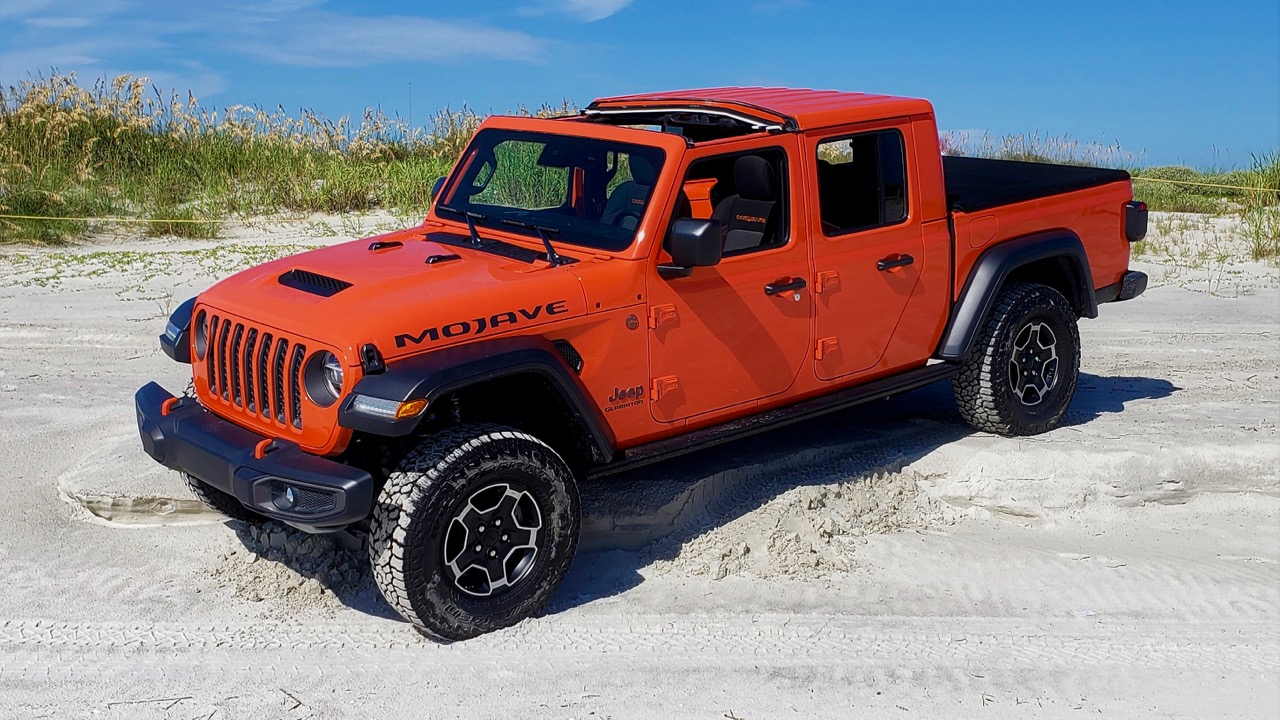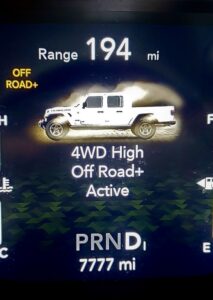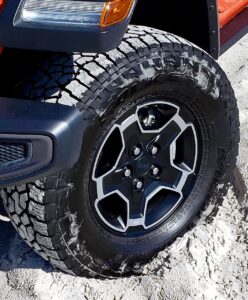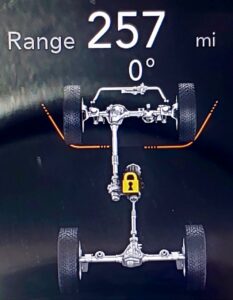There’s nothing stealth about this head-turning, go-everywhere, do-everything Punk’n Metallic ‘20 Jeep Gladiator Mojave Sahara, blogs Dan Scanlan.
We’ve had Jeep pickups for years, from a post-World War II model to an earlier (1963 to 1972) Gladiator pickup, 1980’s CJ Scrambler and 1986-1992 Comanche. But this one’s four portals opens with room for friends, and a real functional cargo box.
Hitting the sand of a local Florida beachfront park, we used its 3.6-liter V-6 with 285 horsepower and 260 pound-feet of torque. Sure, it’s a bit noisy, but our 7,700-mile-old Jeep’s V-6 hit 60 mph in a decent 8 seconds with smooth shifts from the 8-speed automatic. Kickdowns were clean but leisurely during passing. Along with a 5-foot-long pickup bed and 35.5-cubic feetof cargo space, it can tow up to 7,650 pounds. We saw as high as 20 mpg on Regular from a Jeep with flat windshield, some wind noise and tire rumble at highway speed, and just enough sound padding to make it a decent highway rider.
With a new lightweight steel frame and solid axles front and rear, our trail-rated Gladiator’s five-link coil front suspension gained FOX internal bypass shock absorbers all-round with reservoirs, duals on each rear wheel. Add the longer wheelbase and the ride was the most supple I’ve ever felt in a serious Jeep, taut enough to smooth out bumps, yet enough damping to tame the hobby-horsing of a shorter Wrangler.
The off-road rubber had no tread squirm on the asphalt, the 4,974-pound Gladiator pretty neutral in basic cornering. Push harder and it managed curves as we heard the off-road rubber work. Mid-turn bumps didn’t seem to affect it much either. Power steering was direct if a bit over boosted, a hint of play dead center as needed off-road, but needing some minute course corrections on the street. The 12.9-inch front/13.6-inch rear disc brakes had a decent pedal feel and stopped the Jeep well with nosedive at full halt, and no apparent fade after some repeated hard use.
Off-road, the Command-Trac 4×4 system had two-speed transfer case, 2.72:1 low-range gear ratio, rear-axle locker, heavy-duty Dana 44 front and rear axles with a 4.10 rear axle ratio, skid plates and those off-road tires. It can ford up to 30 inches of water, with a 43.6-degree approach angle, 20.3-degree breakover and a 26-degree departure angle. Four-wheel-drive engaged easily on the go as we powered through every sandy trail, even wheel rim-deep ruts. A front – and rear camera that works up to 30 mph came in very handy placing the longer Jeep in tighter tree-lined trails.
Added suspension travel absorbed ruts without jarring, the Gladiator landing softly without any follow-up bounce. It was fairly narrow at 6.15-feet width; black plastic fenders making us feel less nervous about scratches down narrow branch-filled trails. It easily clawed up eroded sandy cliffs. Zipping at 50 mph down a rutted trail saw suspension and longer wheelbase eat up bumps. Low range gave us grunt to easily handle deep sugar sand with traction control disabled. A tight turning radius got it around corners, the only minus from the 19.4-inch longer wheelbase was that we scraped some taller sandy bumps despite the ground clearance.
Despite being 219 inches long vs. a 188-inch Wrangler atop a 137.3-inch vs. 118.4-inch-long wheelbase, our 31-inch-longer Gladiator looked like a Jeep, albeit more long-distance runner than off-road pugilist. It had all the usual cues. But the seven-slot grille gets wider slots for more air intake, swept back with a bit rounder nose. Bright LED headlights have LED DRL halos, with slim turn signals moving to black front fender edges. Tow hooks live atop the hefty bumper, LED fog lights integrated into its tips. It rides on 33-inch Falken Wildpeak A/T tires on 5-spoke silver and black alloy wheels.
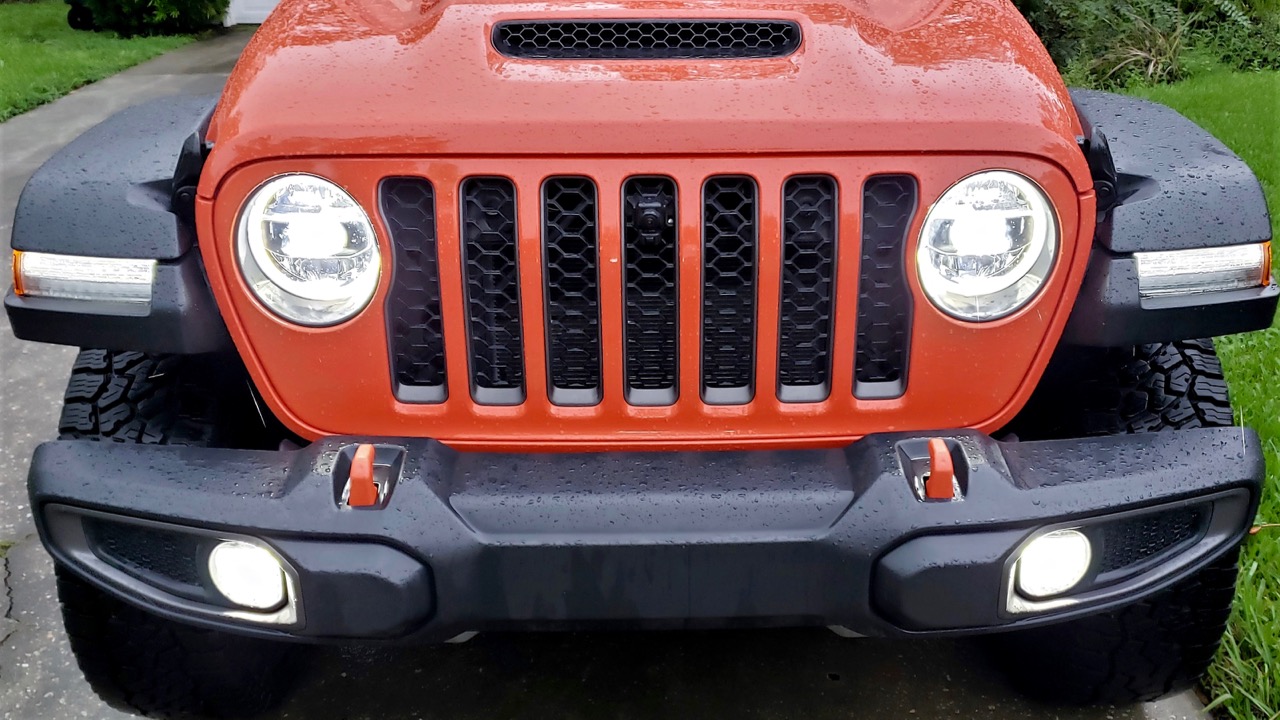 The hood has traditional clamps, plus a hood scoop that does nothing, but looks cool. The slightly swept-back windshield is still mostly flat. Remove four bolts and it folds flat like that original. The square roofline has large windows and 10 inches more C-pillar than short Wranglers. Lightweight T-tops over the front seats unclip quickly and slide into a bag, fitting in the cargo bed. Slab-sided aluminum doors with exterior hinges come off via a ratchet wrench and Torx bit kit packed in the center console. Or use it to unbolt the composite rear roof and cab, leaving only the roll cage. That top needs four to remove, and has to stay at home. There are beefy protective doorsills in black. Another meaty bumper hangs below the tailgate with more tow hooks, traditional square LED taillights attached to bed corners. The 5-foot bed flows neatly off the crew cab, with damped tailgate. The spare goes cleanly under the bed, not seeming to mess with its 11.6-inch ground clearance.
The hood has traditional clamps, plus a hood scoop that does nothing, but looks cool. The slightly swept-back windshield is still mostly flat. Remove four bolts and it folds flat like that original. The square roofline has large windows and 10 inches more C-pillar than short Wranglers. Lightweight T-tops over the front seats unclip quickly and slide into a bag, fitting in the cargo bed. Slab-sided aluminum doors with exterior hinges come off via a ratchet wrench and Torx bit kit packed in the center console. Or use it to unbolt the composite rear roof and cab, leaving only the roll cage. That top needs four to remove, and has to stay at home. There are beefy protective doorsills in black. Another meaty bumper hangs below the tailgate with more tow hooks, traditional square LED taillights attached to bed corners. The 5-foot bed flows neatly off the crew cab, with damped tailgate. The spare goes cleanly under the bed, not seeming to mess with its 11.6-inch ground clearance.
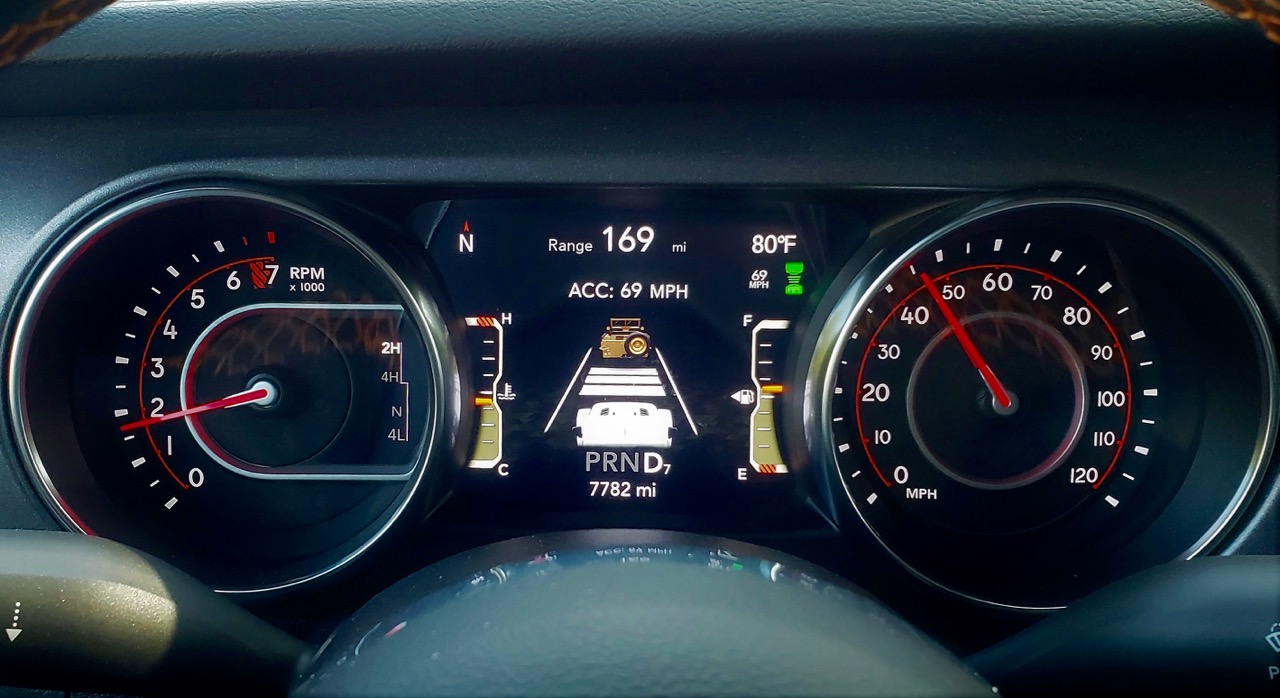 Those doors still get Jeep’s usual thick fabric strap stays, with a smoother, if still flat-faced dashboard inside an almost all-black hard plastic interior with orange and silver accents. There’s some orange stitching. The driver gets clear analog 120-mph speedometer and 7,000-rpm (6,500-rpm redline) tach. In between, a 7-inch display with audio, navigation, fuel economy, tire pressure, tire-fill alert, digital speed readout and adaptive cruise status. You can also call up a pitch and roll display, or the four-wheel-drive/locked center and rear differential status. And heres a heritage cue – the cruise control display shows the back of a classic green WWII Jeep!
Those doors still get Jeep’s usual thick fabric strap stays, with a smoother, if still flat-faced dashboard inside an almost all-black hard plastic interior with orange and silver accents. There’s some orange stitching. The driver gets clear analog 120-mph speedometer and 7,000-rpm (6,500-rpm redline) tach. In between, a 7-inch display with audio, navigation, fuel economy, tire pressure, tire-fill alert, digital speed readout and adaptive cruise status. You can also call up a pitch and roll display, or the four-wheel-drive/locked center and rear differential status. And heres a heritage cue – the cruise control display shows the back of a classic green WWII Jeep!
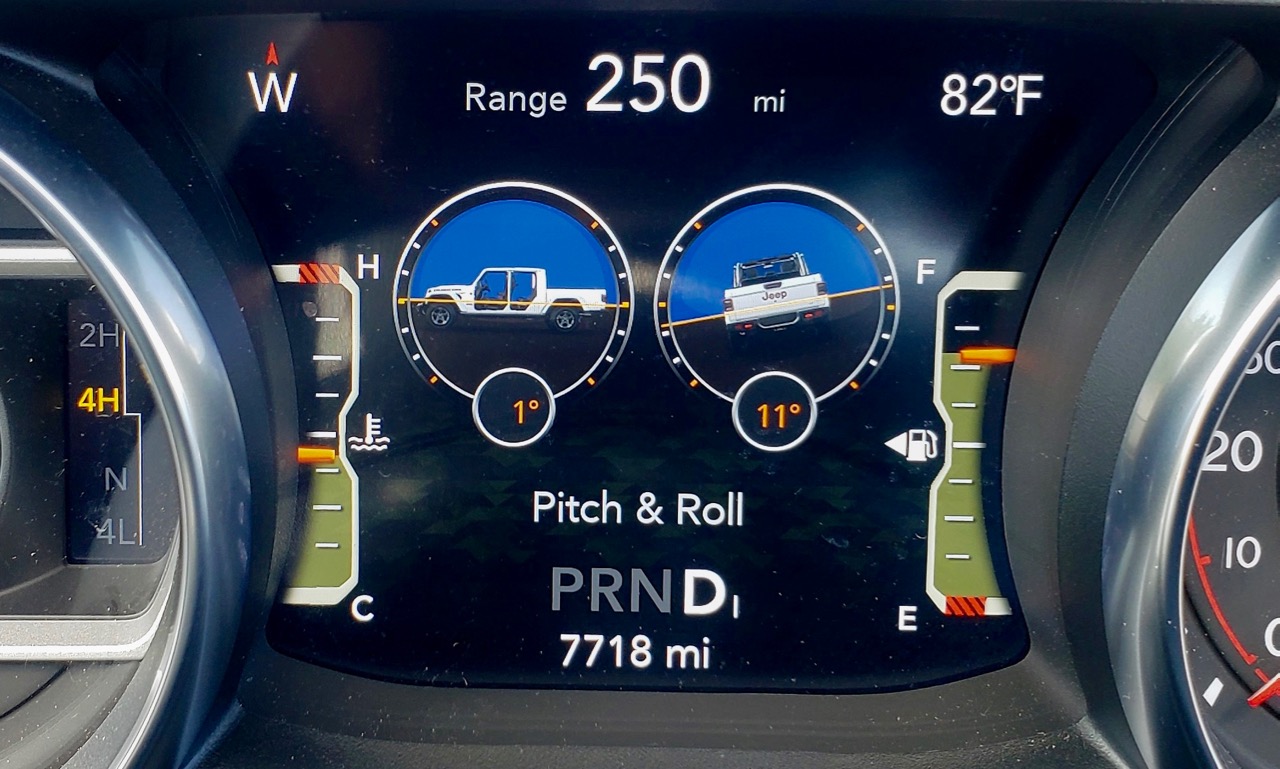 The 8.4-inch Uconnect screen has map, Alpine audio, front and rear cameras, climate control and multiple apps screens with Apple CarPlay, Android Auto, Wi-Fi and more. You can access Off Road pages with larger versions of the gauge’s off-road displays, engine gauges and those cameras. The rear axle lock button is at the center stack base, plus a new Off-Road+ mode that adjusts throttle, transmission and stability control when in 4WD high or low range. Next to that, four buttons to control any aftermarket goodies. There are the big gearshift and transfer case knobs with knurled alloy bases and real metal bolt heads.
The 8.4-inch Uconnect screen has map, Alpine audio, front and rear cameras, climate control and multiple apps screens with Apple CarPlay, Android Auto, Wi-Fi and more. You can access Off Road pages with larger versions of the gauge’s off-road displays, engine gauges and those cameras. The rear axle lock button is at the center stack base, plus a new Off-Road+ mode that adjusts throttle, transmission and stability control when in 4WD high or low range. Next to that, four buttons to control any aftermarket goodies. There are the big gearshift and transfer case knobs with knurled alloy bases and real metal bolt heads.
 Black and gray cloth high-back bucket seats are firmly comfortable and supportive, manual adjustments a tight fit to get to. The rear doors are a bit narrow, but the bench seat has comfortable head and leg room for two adults, locking storage bins under flip-up bottoms. There’s a cargo net on the back wall, plus an Alpine Bluetooth speaker that slots into a charging rack. The pickup bed has a 110-volt outlet, tie-downs and LED lights under a soft cover. The lightweight aluminum tailgate is nicely damped, but with a high load height at 33 inches.
Black and gray cloth high-back bucket seats are firmly comfortable and supportive, manual adjustments a tight fit to get to. The rear doors are a bit narrow, but the bench seat has comfortable head and leg room for two adults, locking storage bins under flip-up bottoms. There’s a cargo net on the back wall, plus an Alpine Bluetooth speaker that slots into a charging rack. The pickup bed has a 110-volt outlet, tie-downs and LED lights under a soft cover. The lightweight aluminum tailgate is nicely damped, but with a high load height at 33 inches.
A base Gladiator Sport starts at $33,545, while our ‘20 Jeep Gladiator Mojave Sahara Mojave launched from $43,875 with $2,295 3-piece removable hardtop; $2,000 8-speed automatic with skid plate; $1,695 Uconnect touchscreen navigation with Alpine sound system, auto-dim mirror and SiriusXM traffic; $1,045 LED lights and more to tally to a hefty $61,505.
‘20 Jeep Gladiator Mojave Sahara boasts serious off-road ability, a comfier on-road drive, and lots of space in a cool package. For more information, please visit https://www.jeep.com/gladiator/mojave

